The Lost Rear-Engine Sprint Cars
Updated in 2008The original version of this webpage dates to 1996, the first season of the IRL. At the time there was an idealistic intention to re-connect Sprint car racing with the Indy 500. More than a decade later, we can see that it's not going to happen... more on that below.
The Rear-engine Revolution
In the mid-1960's, a phenomenon known as the "rear-engine revolution" occured at the Indianapolis 600 in which the rear-engined monocoque formula car layout replaced the front-engined tube frame roadsters over the course of the 1964-1967 seasons. By the early 70's, some rear-engined sprint cars were attempted and were somewhat successful. In 1973, Tom Sneva gathered a disproportionate number of wins in the Gehlhausen Huffaker car (see below).
In 1974, USAC banned the rear-engined sprint cars. Why? Some drivers complained that they were too dangerous or *innapropriate* for the sport... which was counter-argued that those drivers complaining were covering up for not being as good at driving a rear-engined car. Nevertheless, it was feared that the rear-engined layout would become successful very quickly and instantly render obsolete the front-engined cars (like Indy) necessitating everyone to buy new equipment. The difference was that unlike Indy, not everyone at the short-track level could afford all new cars, which would kill the car counts at races.
The Speedway Silver Crown and the PRA
In 2005-2007, a real-life example of switching equipment for an entire sprint car series actually happened. USAC moved it's Silver Crown series to an all new Speedway car, instantly obsoleting the existing cars, somewhat like what the rear-engine sprinters might have done in the mid 70's. The result? The majority of car owners did in fact mutiny, and created their own series, the PRA Big Car Series to run the existing traditional cars. After the 3 seasons, the new USAC Speedway cars were a flop, and the PRA had trouble surviving. As of 2008, a resolution is being sought.
The point is that the Speedway Silver Crown cars show what kind of troubles may have happened in the 70's had the new rear-engine sprint cars been allowed to quickly obsolete the existing field of front engine cars.
Would a rear engine sprint car make a differrence today?
The question remains, would a rear-engined sprinter help get more Sprint car drivers to the Indy 600 today? Probably not. Sure, it would give them some experience in the handling characteristics of a car with a rear weight bias, but not much experience in the details of setting up a monocoque aero "formula car". For that they would still need to spend time in an actual "formula car" feeder series like Atlantics or Indy Pro, and they would still be at an experience deficit compared to drivers who have already spent their whole lower-level career coming up through the formula car ranks. Compound this with the experience sprint drivers already have with front-engined tubeframe cars is well suited to stock cars, it becomes a no-brainer... NA$CAR!
BTW, my favorite local sprint tracks are Williams Grove and Grandview in PA, and Bridgeport in NJ.
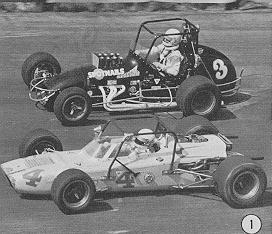
This 1973 photo shows the most dominant rear-engined sprint car of the era, owned by Carl Gehlhausen.
It was actually a Huffaker Indy car which had been converted to a sprinter by Chief Mechanic Eddie Baue.
Driven by Tom Sneva, it collected about a dozen wins in a relatively short period.
The amazing success of this car had a lot to do with the banning. The other front-engined car is driven by Lee Kunzman.
Photo:Jim Chini
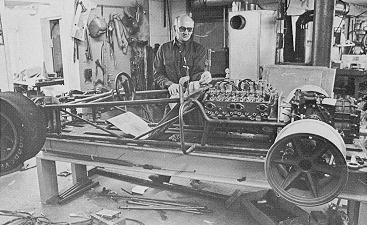
This 1972 photo shows builder Paul Leffler of St.Paul, Ind. in his shop building a rear-engine sprint car.
Notice how low the driver seat is placed.
Photographer unknown
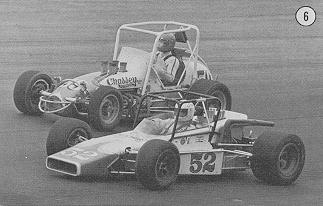
Yet another photo of a RE car leading a FE car on asphalt.
Car#52 is driven by George Snider and #59 is driven by Steve Chassey.
Photo:Jim Chini
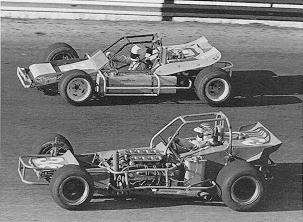
Here's two possible interpretations of the term mid-engine.
At Salem Speedway, Bob Stelter is in the offset roadster-sprinter while Gary Allbritain is in the sprinter.
Photo:John Mahoney
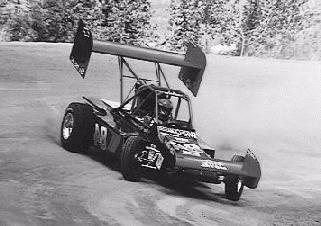
Rear engine winged outlaw? No, it's Gary Lee Kanawyer winning the 1997 Pikes Peak Open Wheel division.
This car is a 1981 Coyote with a 430cid Chevy engine.
Photo:Larry Buche
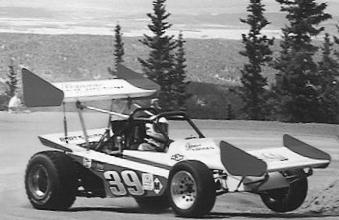
Most of the Pikes Peak open wheel division cars are rear-engined.
Here's Stan Kossen in his Chevy powered car.
Photo:Larry Buche
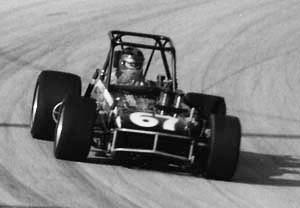
The Dowker Roadster as an example of lower CG
Why would a rear-engine sprint car be faster? Surely, having a smaller frontal surface area will cut down on drag. However, the traditional front engine sprinter does has a very high CG (center of gravity) due to the driver sitting high directly above the drive shaft. Without that problem, the CG in a rear engine car can be made much lower. Low CG = better cornering = speed!
So what if a front engine sprint-car was built in which the driver was placed to the side
of the drive-shaft like a roadster? Would it be as fast as a rear
engine sprint car? In the late 70's such a car was built by Butch Dowker
called the "Titanium Roadster". It featured many design tricks, but
most importantly, it had an obviously lower CG, due to the driver
sitting lower by the offset driveshaft. The Titanium Roadster won a LOT
of races in the '78-'79 seasons, until it too was banned. It now sits in
a museum, and still carries the title of "World's Fastest Sprint Car". Shown is Steve Chassey at Toldeo, Ohio, 1979.
Photo:JCRoche